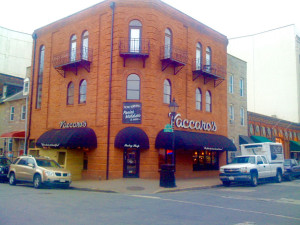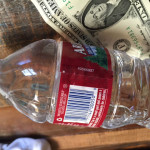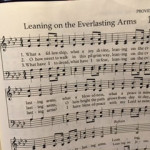The Baltimore We Love
I love Baltimore. Two of our three kids were born there. We lived there, moved away, moved back, and have since moved across the country, but we put a total of 15 years of our lives into that city and it’s in our blood.
Mark and I moved there in 1987, our worldly goods in a U-Haul truck. We moved into the Northway Building, in Charles Village, and thought it was the most sophisticated place we had ever seen, even in its faded Art Deco glory, with its brass mail chutes and 14-foot ceilings, elegant lobby and parquet floors. We loved living on Charles Street, with its “glass-phalt,” one of legendary mayor William Donald Schaefer’s ideas, where glass was mixed in with the pavement so that it sparkled. Those were the days of the dollar houses — grand old row homes in downtown Baltimore, being sold for a dollar to people who were willing to put in the sweat and money to fix them up.
Once, we walked all the way down Charles Street to the Inner Harbor. We walked past the edge of Guilford, with its grand homes and tree-lined, twisting streets, past University. Turn left and we would have walked, as we often did, to Memorial Stadium, “The Old Grey Lady of 33rd Street,” or “The World’s Largest Outdoor Insane Asylum,” where the Orioles used to play, in a neighborhood with Chinese restaurants and used bookstores, and where the Baltimore Colts once played, before they left town in the middle of the night. Past the monument to the Confederate Women (Baltimore is south of the Mason-Dixon line, and used to be considered more of a Southern city than it is now), past Johns Hopkins University. Past North Avenue, where the neighborhood was a little sketchy but there were also some great old book stores. Past beautiful Penn Station with the mechanically moving, non-digital train arrival and departure board that I never got tired of watching.
Past Mt. Vernon, with its Washington Monument — the original one, before that copycat one in D.C. — and its exquisitely beautiful Methodist Church and the Peabody Preparatory and Conservatory, with one of the most beautiful libraries ever. Fun fact: As a Johns Hopkins employee, I got a tuition discount and was able to take jazz piano lessons with the great Charles Covington, the foremost expert on Eubie Blake’s stride piano style (Eubie Blake, another source of Baltimore pride), a world-class musician and just a decent, humble, kind gentleman.
Past the Walters Art Gallery, which later made its admission free to the public just because it could. It has many beautiful works of art, but I remember most its suits of armor and some kind of Mediaeval skeleton boxes with a message like, “What you are, I once was, and what I am, you will be.” Reminders of mortality.
Past great restaurants that seemed so exotic to us — The Brass Elephant, Ruth’s Chris Steakhouse, Louie’s Bookstore Cafe´ and the Charles Theatre, across the street, the legendary bar Club Charles, past the Helmand, where I ate my first Afghan food, past Akbar Restaurant, where I ate my first Indian food, past Tony Cheng’s, the most elegant Chinese Restaurant (although our hearts really belonged to Uncle Lee’s, near Memorial Stadium).
Past the Lyric Opera House on Mount Royal (go the other way and you could wind your way to the Meyerhoff Symphony Hall, where Baltimore’s world-class Symphony Orchestra plays). Eventually we made it to the Inner Harbor. This was before Camden Yards, before the Light Rail Line, before the Ravens existed as a Baltimore football team, and still, the Inner Harbor was the crème de la crème. Shops, restaurants like Taverna Athena, past the Lady Maryland schooner, the newly opened Renaissance Harborplace Hotel with fancy stores like Brooks Brothers. The National Aquarium, one of our favorite places in the world, with its rescued, three-legged giant sea turtle and its beautiful rain forest. The Science Museum.
Turn left at the Harbor, and you get to Little Italy, home of several favorite places. Sabatino’s, of course, the amazing restaurant owned by a family who later became good friends of ours, open til the wee hours. Once, Mark and I saw Tony Bennett singing with the Baltimore Pops, then we went to Sab’s for calamari and pasta with olive oil and garlic, and there was Tony, having his late supper, too. Vaccaro’s, the Italian bakery, home of the best pignoli and Amaretti cookies ever. Home of row houses with white stoops, lovingly polished every morning by ladies who had lived there all their lives. Home of backyard bocce courts, with lawn chairs set up to watch nightly battles. Of an artist named Tony, who sat on one of the Four Corners (intersection of four great restaurants of Little Italy) and sold pen-and-ink sketches of Little Italy and took care of his elderly mother.
If we kept going East, we would wind our way to Eastern Avenue and on into Highlandtown, home of Matthew’s deep-dish Pizza, home of Haussner’s, which is no more, but which had to be experienced to be believed. It was German food, eaten amid a collection of fine art and many Rococo pieces. Weird, and yet iconic. So Baltimore. And then Greektown, block after block of Greek coffee shops and restaurants.
And then, south of Eastern Ave., Fells Point, home of cobblestone streets, 400-year-old houses, tiny shops, and on South Baltimore, past the Christopher Columbus statue, past the hospital where Edgar Allan Poe died, Jimmy’s restaurant, where Mark and colleagues used to go and have a beer at 7:30 in the morning after working all night in the ER at Johns Hopkins Hospital during his internship.
I haven’t mentioned the Baltimore Zoo, the numerous crab houses, duckpin bowling (with smaller, bocce-sized balls and tiny lanes), snowball stands (everywhere else but Baltimore, these are called snow cones), the food markets in the city where we could walk and get produce, flowers, sandwiches, kimchee, fresh fish, and fresh-butchered meat.
I didn’t talk about Roland Park, an elegant neighborhood once considered the suburbs, where most of the Queen Anne-style houses were made from kits purchased through the Sears Catalog and delivered by rail. Or Eddie’s Supermarket, where you could sign for your groceries with your four-digit number, and where I once stood in line behind John Waters, legendary director of movies like Hairspray, Pink Flamingos, and my favorite, Polyester (filmed in Odor-ama, with scratch-n-sniff cards) starring Divine and Tab Hunter. I remember thinking, “Wow, his mustache really is pencil-thin!”
I haven’t told you how we saw Barry Levinson’s two great Baltimore movies, Diner and Tin Men, and drove around the Hampden neighborhood, block after block of row houses, looking for where they were filmed. I haven’t talked about Mount Washington, a quirky neighborhood with a Tavern that made it into the Preppy Handbook. The Domino Sugar sign, once the world’s largest neon sign. Bethlehem Steel and Old Bay and Natty Boh, the hometown beer. The Shot Tower, where they used to drop molten lead shot into vats of cooling water in the 1800s. The Flag House on Pratt Street, where Mary Pickersgill and some other ladies sewed a giant flag that remained proudly flying during the siege of Fort McHenry in the War of 1812. Francis Scott Key was so moved by the sight of this flag that he wrote the song, to the tune of a difficult-to sing drinking song, that is now our national anthem.
I have barely scratched the surface.
Baltimore is engulfed in riots tonight. We’re watching it on TV and following the posts of our many friends who are trying to process what is happening to the city we love. Because although you can take the people out of Baltimore, you’ll never take the Baltimore out of the people who love it. Tonight, we’re crying for an old and very dear friend.
Hang on, Baltimore. There’s too much good in you to let the bad keep you down.
©Janet Farrar Worthington





This is a moving and lovely tribute to Baltimore, the city you love. I lived in Philadelphia during grad school and then in Arlington, VA for several years (and so spent quite a bit of time in Baltimore and love reading about it in every Laura Littman novel I read). My heart is breaking for a city that has not yet learned, in all these years, to love one’s neighbors as themselves. It is time to literally turn the other cheek and be the first to actively forgive. About the only thing stronger than human frailty and violence is the human spirit.
Thank you, Judith. I agree with you 100 percent. Also about books: — I’m looking at my signed copy of “The Sugar House, a Tess Monaghan Mystery” right now, with the Domino Sugar sign on the cover. Also, “The Horse You Came In On” by Martha Grimes, another favorite in my Baltimore mystery section. Baltimore will come back from this. It has to! Thank you so much for writing.